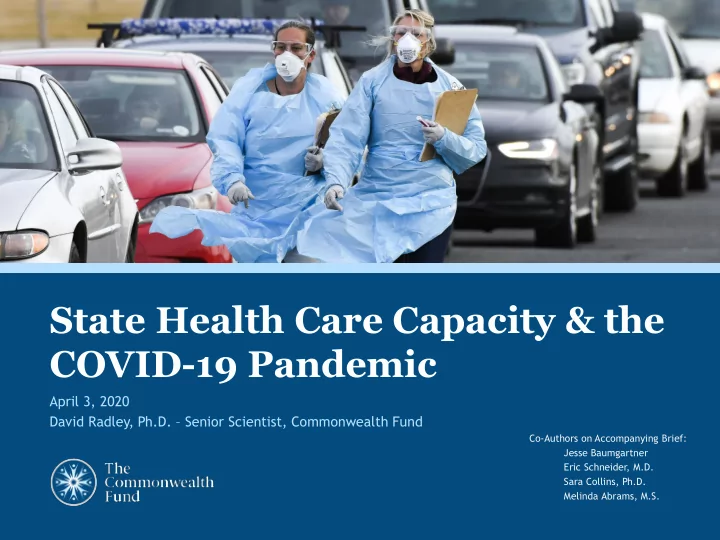

State Health Care Capacity & the COVID-19 Pandemic April 3, 2020 David Radley, Ph.D. – Senior Scientist, Commonwealth Fund Co-Authors on Accompanying Brief: Jesse Baumgartner Eric Schneider, M.D. Sara Collins, Ph.D. Melinda Abrams, M.S. 1
Confirmed COVID-19 Cases per 100,000 adults March 26, 2020 April 2, 2020 Less than 25 confirmed cases per 100,000 adults 25 per 100,000 to 74 per 100,000 adults 75+ confirmed cases per 100,000 adults Data: Johns Hopkins University Center for Systems Science and Engineering (JHU CSSE). 2 Obtained on April 2, 2020.
Assessing state level risk, physician supply & hospital capacity High Risk Population Hospital Capacity Physician Supply • Age 65 and older • Acute care bed • Current and surge capacity scenarios • Age 18-64 with a chronic Illness • Intensive Care Unit • Ambulatory capacity (ICU) bed capacity for triage and − COPD or Asthma, management Diabetes, Heart • Ventilator supply disease, severe • Hospital-based obesity physicians familiar with admitting and • State rates: 36%-53% managing patients in • ≈107 million adults inpatient settings Data available for download in excel format @ 3 CommonwealthFund.org
High Risk Populations Share of State Population Age 65+ or Age 18-64 with a Chronic Illness 36% - 40% (7 states) 40% - 44% (29 states) 45% - 53% (15 states) Note: Chronic illness include COPD, Asthma, Diabetes, Severe Obesity (BMI >= 40) 4 Data: Behavioral Risk Factor Surveillance System (BRFSS), CDC, 2020
Current and Surge Physician Capacity Additional physician capacity under surge scenario Current Physician Assistant & Nurse Practitioner Current Hospital/ICU Management Current Ambulatory Triage and Management Higher Supply Lower Supply Notes: Ambulatory includes General Practice, Family Medicine, and Medical Specialty who work in ambulatory settings; current hospital/ICU includes General Practice, Family Medicine, Medical Specialty, Anesthesiology, Emergency Medicine, and Surgical specialists who work in a hospital setting; Surge scenario includes physicians in categories above who currently work primarily in research, teaching, or administrative roles Data: Area Health 5 Resource File, HRSA, 2018-19 release
Physician Surge Capacity Explained New York Additional Surge Capacity 450 10.8 per 100,000 (about 2,100 physicians) 400 100,000 residents Physicians per 350 Current Hospital/ICU Management 149.0 per 100,000 300 250 Current Ambulatory Triage & 200 Management 91.3 per 100,000 150 Physician Asst. & Nurse 100 Practitioner 159.7 per 100,000 50 0 Current Surge Notes: Ambulatory includes General Practice, Family Medicine, and Medical Specialty who work in ambulatory settings; current hospital/ICU includes General Practice, Family Medicine, Medical Specialty, Anesthesiology, Emergency Medicine, and Surgical specialists who work in a hospital setting; Surge scenario includes physicians in categories above who currently work primarily in research, teaching, or administrative roles Data: Area Health 6 Resource File, HRSA, 2018-19 release
Hospital Bed and Ventilator Supply Ventilator Supply Intensive Care Hospital Bed Supply Acute Care Hospital Bed Supply Higher Supply Lower Supply Data: Hospital Bed Supply: Harvard Global Health Institute analysis of American Hospital Association data (2018) and American Hospital Directory (https://globalepidemics.org/our-data/hospital-capacity/); Ventilator: Estimated number of full-feature mechanical ventilators owned by acute care hospitals in each state per 100,000 residents; Lewis Rubinson et al. Mechanical ventilators in US acute care hospitals. Disaster Medicine and Public 7 Health Preparedness 4, no. 3 (Oct 2010): 199-206.
Mobilizing health care resources in uncertain times • Healthcare delivery systems in all states facing unprecedented challenges • Facilities in New York, New Jersey, and Louisiana on the precipice of exceeding the capacity of their health systems and workforce • State governments have emerged as the locus of policy action to mitigate the virus’ spread − Enacting social distancing policies, − Mobilizing resources and infrastructure 8
Recommend
More recommend